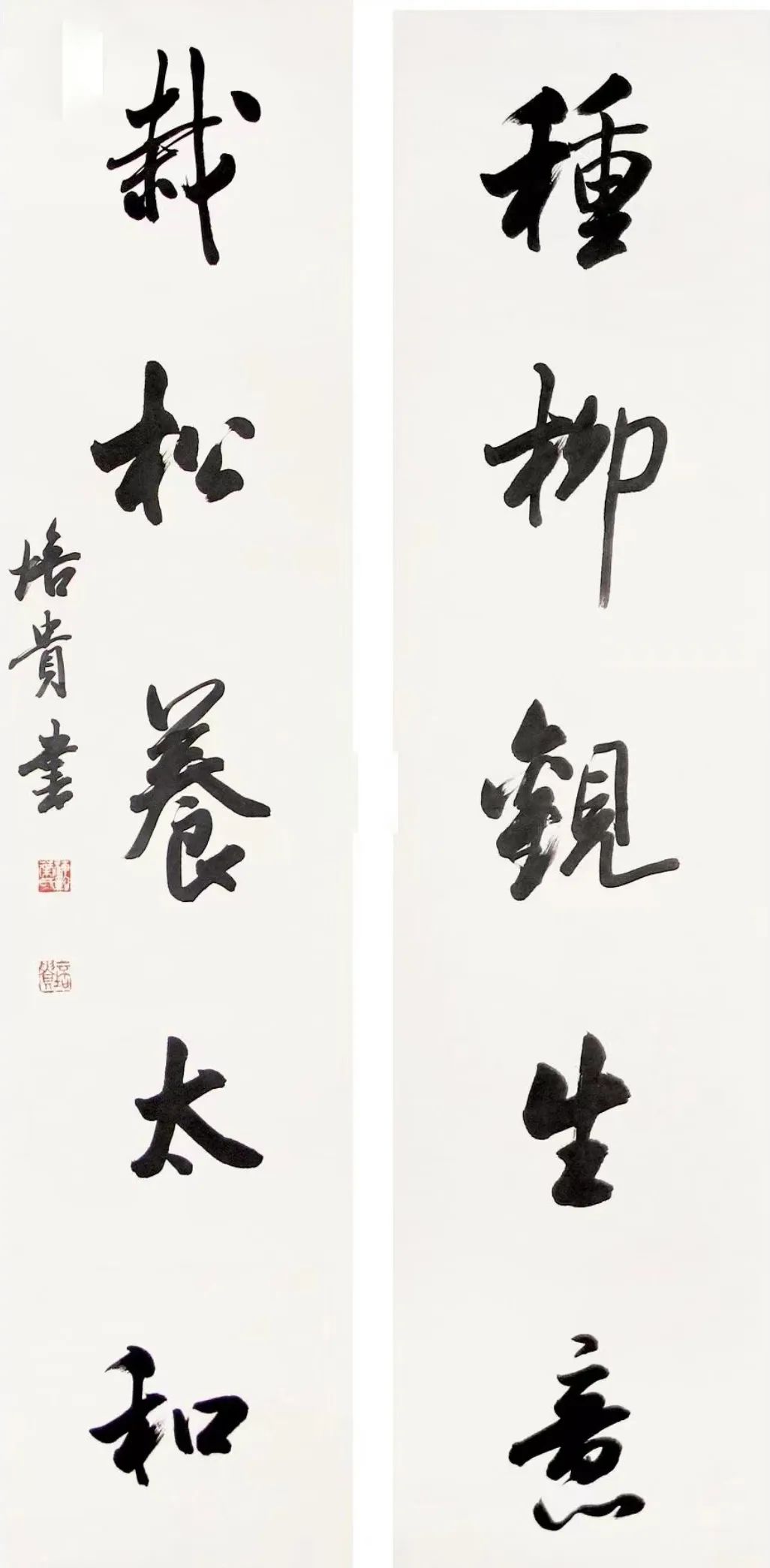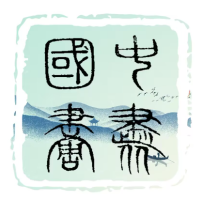书者叶培贵,抱朴守拙,自喻愚鲁,不事雕饰,唯执笔循道。恒以书册为记,如行旅寸履,步步铭心。常叹己艺未臻大成,犹涉途径,未敢自许功名。恩师欧阳中石之言如晨钟暮鼓:“岁月无私,世间自有衡准。”此训犹清露润心,令其常怀谦退,不忘本初。

其书堂于师大,四壁森陈简帙,幽香萦绕。斯地既为研思之室,亦为挥翰之处。每于书影墨香间探古索微,冥心而究其道。叶公少长于经艺,三十六载便登讲席,不数年而授博士高弟。传授所及,综览史法,贯通词章,融草隶行楷之妙。学海涵泳,致广大而尽精微。
叶培贵以羲米为宗,旁稽百家,融铸为体。初研褚法,心契其清健遒逸,笔下精微,取以砥行。及至行草,推重米公,喜其风骨纵横,气象凌厉,笔走烟霞,神采自生。授徒授业,奉训守经,选帖必择千载所重,循古道以开新径。时日既久,羲米之意深蓄胸臆,化为腕底家常。
少岁读书顺昌,家教崇文,常叹饥可忍,书不当废,遂凝心苦学,未尝一懈。初二闻刘师板迹,简远而劲,意逸于行,心生慕仰,日日临摹,渐成自家笔韵。高年入青宫班,黄师一顾,见其笔路虽略柔,然骨架严整,势潜其间,遂破格收为门末。丁卯书赛,闽中才彦荟萃。黄师赐书论,授以雄风精义,劝其观中州遗帖,昼夜探研,墨迹盈案。展时出“山静松声远,秋清泉气高”,观者屏息,评席叹服。桂冠既获,非徒增誉,更定一志,自此栖心翰海,涵濡古意,步履寂然,毫端不歇。



叶培贵耽心翰墨,履迹恒定,内观其本,外纳群言,以砥行深。研、教、创三途并驱,浑然一体,如川岳并峙,脉流相通。授徒不囿于传授笔法,常与学子往复探求,以求意契神融。自谦愚鲁,于诸艺途,步步慎行,未尝懈怠,若临渊水,惟恐失衡。
于书道蕴理,未尝自满,恒叹所窥未深,心志长寄于远。研米芾之遒劲,摹褚遂良之雅秀,参李北海之高迈,溯羲皇之风规。持文心以正书脉,涵古意以蕴墨魂,出入正道,自成清雅高致。常慨文人之学浩若烟海,虽穷力研思,所获如一瓢弱水,未得其源,仰而不及。
平居所行,涵书卷清韵。观佳卷,心凝如镜;授一课,神畅气朗;习古帖,腕随气行;散步闲庭,襟怀若洗。日月往复,惟求墨道静明,心神契合。此寂然丰盈之境,于其念,乃书道妙趣所归,心魂安栖之地。
题材所涉,多钟诗文,谓翰墨与诗篇同脉共鸣,若春风与华林,相激而发,葳蕤生光。顾书道三十载盛时,风雷激荡,文化复兴,步新政潮涌,纳百家之音,艺境拓新而宏远。叶公常怀嘉许,叹盛象可期,亦知兴替常态。望其流转,虑其久安,辨中枢之势,观大局之流,未尝以细瑕废其通功。



论笔墨之道,叶培贵言其随世而进,亦需审慎度观。应时而行非尽趋于时尚,反可失真;不应流俗,或存超然之境。大道难明,惟见微知著者,能契世之音,甚或洞见未来,成后世之望。
及其用时,恒依事缓急而动。间暇之际,凝神挥翰,教务繁忙,则取隙以温旧帖,涵咏其旨。曾应信阳旧友所请,书录何景明诗文为册,刊之于河南美术社,以彰乡贤文脉。叶公为此倾注心力,因感其诚挚之心,如斯举动,言志甚深。
叶公恒言创作难在于心。今之世,物资丰盈,帖本易觅,研摹之便,古未及此。然手可易工,心难至真。文化嬗变,新旧交替,旧制有损而新义未成,正当有心探途,庶免迷茫虚浮。言及传道,尤重教化之根,需经制完善,纲纪可循,使翰墨不失根本。知惟师者自强,涵养学力,方堪为道之引领,示学子以正。叶公功勋已著,而恒持谦退之姿,自勉行路未休,望以四方同道之教,策志更进,不惑初心。




Ye Peigui: Steadfast in His Pursuit of Grace and Strength, Upholding His Original Aspiration Through Calligraphy
The calligrapher Ye Peigui upholds simplicity and remains steadfast in his humility, often regarding himself as naive and unsophisticated, refraining from embellishment and adhering solely to the essence of his craft. He consistently treats books as records of his journey, like a traveler marking each step with care and reflection. He often laments that his artistry has yet to reach its zenith, seeing himself as still traversing the path and never daring to claim mastery. The words of his mentor, Ouyang Zhongshi, resonate like the toll of a morning bell: "Time is impartial, and the world has its own measures of fairness." This teaching, like dew moistening the heart, keeps him grounded in humility, never straying from his original purpose.
His study at the Normal University is lined with shelves of books, exuding a lingering fragrance of ink and paper. This space serves both as a room for deep contemplation and a place where his brush dances upon the paper. Immersed in the shadows of calligraphy and the aroma of ink, he delves into the ancient traditions with a focused mind, seeking the profound essence of the art. Ye, well-versed in bothical learning and artistic craft, ascended to the lectern at the age of thirty-six and, within a few years, became a mentor to doctoral students. His teachings encompass the breadth of historical principles and poetic composition, interweaving the subtleties of cursive, clerical, and running scripts. In the vast sea of scholarship, he swims deeply, striving to reach the heights of greatness while mastering the finest details.
Ye Peigui revered Wang Xizhi and Mi Fu as his guiding lights, while drawing inspiration from various masters to forge his own path. In his early studies, he immersed himself in the calligraphy of Chu Suiliang, captivated by its elegance and strength, with each stroke revealing profound precision. When he shifted to running script, he was drawn to Mi Fu’s unrestrained spirit, whose brushwork surged like rolling clouds and rushing streams, exuding unmatched vitality. In his teaching, he adhered to tradition with unwavering dedication, selecting only the most reveredics to pass on to his students. Over time, the essence of Wang and Mi’s artistry became an inseparable part of his craft, flowing naturally from his hand.
In his youth, Ye studied in Shunchang, nurtured by a family that revered scholarship. His elders often reminded him that hunger may be endured, but the pursuit of knowledge must never be forsaken. This instilled in him an unwavering resolve to persevere in his studies. In middle school, he encountered the handwriting of his mathematics teacher, Liu Weimin—simple yet powerful, imbued with a flowing elegance that resonated deeply. Inspired, he practiced tirelessly until his brushwork bore his own distinct character. In his final year, he joined the county’s youth calligraphy academy. Huang Jianxun, the instructor, observed his work—though the strokes were not yet forceful, the structure was balanced and full of latent potential. Recognizing this promise, Huang admitted him as the last student.In the year of Dingmao, a grand provincial calligraphy competition gathered talents from all corners of Fujian. Huang guided him with insightful teachings on capturing boldness and spirit and recommended masterpieces from the heartland for his study. Ye immersed himself day and night, filling his desk with ink-stained papers. When the exhibition arrived, he presented his work, “The Pines Stand Silent, Their Whisper Distant; The Autumn Spring Runs Pure, Its Fragrance High.” The audience held their breath in admiration, and the judges were unanimous in their praise. He claimed the highest honor—not merely as a mark of distinction but as a turning point that cemented his lifelong commitment. From then on, he devoted himself wholly to the art, cultivating the grace of ancient masters with quiet determination and tireless refinement.
Ye Peigui immersed himself in the art of calligraphy with unwavering dedication, reflecting inward to refine his heart while listening outward to absorb diverse insights. He viewed research, teaching, and creation as a harmonious whole, akin to rivers converging in their course and mountains standing side by side. In teaching, he did not merely impart techniques but sought mutual enlightenment through dialogue with his students, striving for resonance in both mind and spirit. Humble by nature, he often called himself slow-witted and advanced with caution, as if treading along the edge of an abyss, never daring to falter.
In contemplating the essence of calligraphy, he never rested in complacency but lamented his limited grasp of its profound depths. He studied Mi Fu's bold grace, emulated Chu Suiliang's refined elegance, and admired Li Beihai's lofty strength, tracing the lineage back to Wang Xizhi’s timeless mastery. Anchoring his calligraphy in literary sensibilities, he infused it with ancient spirit, adhering to the righteous path while shaping a style of subtle elegance. He often sighed at the boundless breadth of the literary tradition, knowing that despite his earnest efforts, his understanding was but a sip from an endless stream, leaving him with a sense of awe and unattainable aspiration.
His daily life exuded the serenity of scholarly pursuits. Reading fine texts sharpened his mind; teaching invigorated his spirit; practicing ancient scripts attuned his hand; wandering amid quiet courtyards refreshed his heart. With the passage of days, he sought to harmonize his inner world with the tranquil essence of calligraphy, finding solace in its profound mysteries and making it the resting place of his soul.
In terms of subject matter, he was especially drawn to poetry and prose, believing that calligraphy and literature shared the same pulse, mutually inspiring and illuminating, like spring breezes stirring a grove into bloom. Reflecting on the three decades of calligraphy’s revival, he regarded it as an era of brilliance—a time when cultural currents surged forth, and the art reclaimed its rightful place amid reform and renewal. He marveled at the openness and innovation of the era while remaining aware of its inevitable imperfections. Yet, in observing the tides of change, he maintained focus on the broader course, never letting small flaws obscure the grand vision of progress.
责任编辑:苗君
